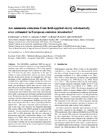Are ammonia emissions from field-applied slurry substantially over-estimated in European emission inventories?
dc.contributor.author
Sintermann, Jörg
dc.contributor.author
Neftel, Albrecht
dc.contributor.author
Ammann, Christoph
dc.contributor.author
Häni, Christoph
dc.contributor.author
Hensen, Arjan
dc.contributor.author
Loubet, Benjamin
dc.contributor.author
Flechard, Christophe R.
dc.date.accessioned
2018-09-21T15:36:32Z
dc.date.available
2017-06-10T00:44:27Z
dc.date.available
2018-09-21T15:36:32Z
dc.date.issued
2012
dc.identifier.issn
1726-4170
dc.identifier.issn
1726-4170
dc.identifier.other
10.5194/bg-9-1611-2012
en_US
dc.identifier.uri
http://hdl.handle.net/20.500.11850/48959
dc.identifier.doi
10.3929/ethz-b-000048959
dc.description.abstract
The EMEP/EEA guidebook 2009 for agricultural emission inventories reports an average ammonia (NH3) emission factor (EF) by volatilisation of 55% of the applied total ammoniacal nitrogen (TAN) content for cattle slurry, and 35% losses for pig slurry, irrespective of the type of surface or slurry characteristics such as dry matter content and pH. In this review article, we compiled over 350 measurements of EFs published between 1991 and 2011. The standard slurry application technique during the early years of this period, when a large number of measurements were made, was spreading by splash plate, and as a result reference EFs given in many European inventories are predominantly based on this technique. However, slurry application practices have evolved since then, while there has also been a shift in measurement techniques and investigated plot sizes. We therefore classified the available measurements according to the flux measurement technique or measurement plot size and year of measurement. Medium size plots (usually circles between 20 to 50 m radius) generally yielded the highest EFs. The most commonly used measurement setups at this scale were based on the Integrated Horizontal Flux method (IHF or the ZINST method (a simplified IHF method)). Several empirical models were published in the years 1993 to 2003 predicting NH3 EFs as a function of meteorology and slurry characteristics (Menzi et al., 1998; Søgaard et al., 2002). More recent measurements show substantially lower EFs which calls for new measurement series in order to validate the various measurement approaches against each other and to derive revised inputs for inclusion into emission inventories.
en_US
dc.format
application/pdf
dc.language.iso
en
en_US
dc.publisher
Copernicus
en_US
dc.rights.uri
http://creativecommons.org/licenses/by/3.0/
dc.title
Are ammonia emissions from field-applied slurry substantially over-estimated in European emission inventories?
en_US
dc.type
Journal Article
dc.rights.license
Creative Commons Attribution 3.0 Unported
dc.date.published
2012-05-03
ethz.journal.title
Biogeosciences
ethz.journal.volume
9
en_US
ethz.journal.issue
5
en_US
ethz.pages.start
1611
en_US
ethz.pages.end
1632
en_US
ethz.version.deposit
publishedVersion
en_US
ethz.identifier.wos
ethz.identifier.nebis
006289717
ethz.publication.place
Göttingen
en_US
ethz.publication.status
published
en_US
ethz.date.deposited
2017-06-10T00:44:34Z
ethz.source
ECIT
ethz.identifier.importid
imp59364f33e4e4b79898
ethz.ecitpid
pub:80596
ethz.eth
yes
en_US
ethz.availability
Open access
en_US
ethz.rosetta.installDate
2017-07-12T21:41:59Z
ethz.rosetta.lastUpdated
2021-02-15T01:51:06Z
ethz.rosetta.versionExported
true
ethz.COinS
ctx_ver=Z39.88-2004&rft_val_fmt=info:ofi/fmt:kev:mtx:journal&rft.atitle=Are%20ammonia%20emissions%20from%20field-applied%20slurry%20substantially%20over-estimated%20in%20European%20emission%20inventories?&rft.jtitle=Biogeosciences&rft.date=2012&rft.volume=9&rft.issue=5&rft.spage=1611&rft.epage=1632&rft.issn=1726-4170&1726-4170&rft.au=Sintermann,%20J%C3%B6rg&Neftel,%20Albrecht&Ammann,%20Christoph&H%C3%A4ni,%20Christoph&Hensen,%20Arjan&rft.genre=article&rft_id=info:doi/10.5194/bg-9-1611-2012&
Dateien zu diesem Eintrag
Publikationstyp
-
Journal Article [128858]

